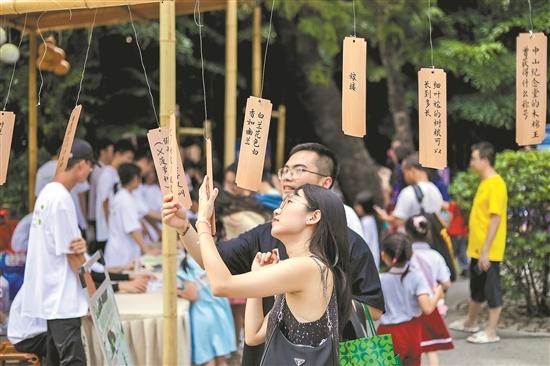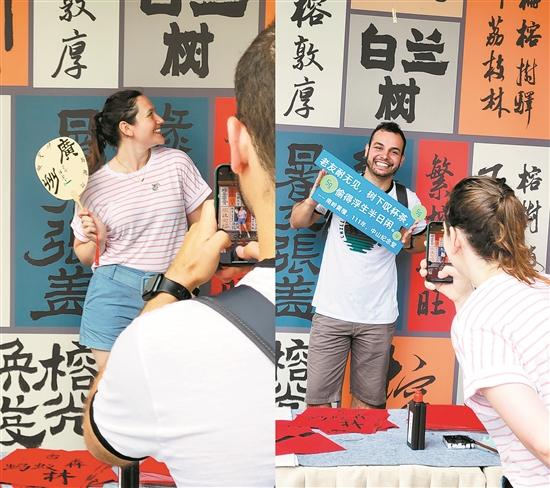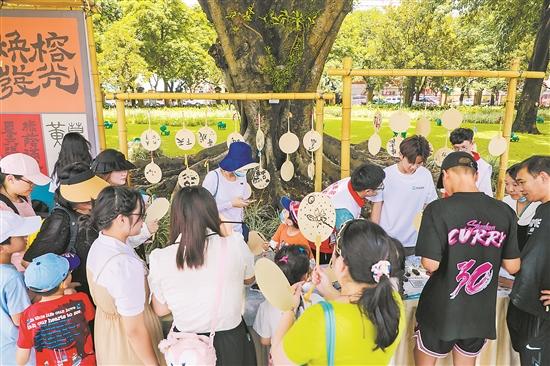Ancient trees are valuable non-renewable resources that decorate every city and witness its social, economic, and cultural development, carrying the urban memories and nostalgia of generations.
Guangzhou has always highly valued the management and protection of ancient trees. From June 22nd to24th, an offline public benefit activity titled"My City, My Tree" kicked off in Guangzhou to explore the most beautiful ancient trees, attracting thousands to participate and take photos for social media sharing.

It is commonly acknowledged that ancient trees are"old objects" that seem remote from young people. Instead, young people have special feelings for ancient trees. There were college students among the crowd who shared their understanding of protecting ancient trees in the activity.
"When you truly step into the mountains and forests and perceive the traces of time printed on ancient trees with your eyes and hands, a sense of awe arises naturally. It's not just a towering tree, but also a builder and witness of the ecological environment," said Ge Qingyu, a forestry major student at South China Agricultural University."We, as forestry researchers, can also infer long-term changes in the local environment from the growth of ancient trees, providing a theoretical basis for our future ecological protection."
"Ancient trees serve as living cultural relics," said Gong Xinmiao, also a forestry major at South China Agricultural University."An ancient tree to me is simply a tree when I know little about the story behind it. But after I knew what it experienced, it seemed to turn into an old man who has gone through vicissitudes when seeing its winding roots and rough, cracked bark again."

In Guangzhou, each ancient tree has its own"identity card". In 2022, Guangzhou assigned professional agencies to send tree doctors to conduct uninterrupted health inspections and monitoring of over 9,000 local ancient trees, update their archives, and closely follow their growth. What people perceive the protection of ancient trees in Guangzhou is that the city does well in making tree identity cards and telling stories well. To Guo Yundan, a second-year postgraduate in forestry major at South China Agricultural University, the identity codes in the electronic information database enable the implementation of precise management for each tree."Media reports and narratives have deepened the public's understanding of the significance of ancient trees. Public participation is indispensable for the protection of ancient trees," said Guo.
In May, the"Public Benefit Support Project for Protecting Ancient Trees in Guangzhou" was launched as the first batch nationwide. The project, co-launched by the Bureau of Forestry and Landscaping of Guangzhou Municipality and"Ant Forest" (an Alipay program to encourage its users to lower carbon emissions by planting trees), allows supporters to help protect ancient trees in Guangzhou by participating in the"Ant Forest" program on Alipay. By the end of 2022,"Ant Forest" program had planted more than400 million trees, participated in the joint construction of more than 2,700 square kilometers of protected areas, and carried out scientific planting of 500 mu (about 33.3 hectares) of seagrass beds and ecological restoration of 1,000 mu (about 66.6 hectares) of mangrove forests.

Such a project with great online attention has attracted nearly 20 million online participants within just one month. According to statistics, there are more than 9,000 ancient trees in Guangzhou distributed across11 districts. Various types of ancient trees, such as the kapok king, white champaca trees, banyan trees, and Dalbergia balansae (a species of legume found in South China and Vietnam) have been successively introduced online on Alipay.
The"My City, My Tree" activity to explore Guangzhou's most beautiful ancient trees extends activities from online to offline, offering comprehensive support for the protection of ancient trees in Guangzhou.
年轻人也有古树情怀!00后热衷用这种方式保护古树名木
古树,是每个城市的一道亮丽风景线。作为不可再生的宝贵资源,古树是社会、经济、文化发展的见证者,承载着一代又一代人的城市记忆和乡愁。在广州,古树名木的管理与保护历来受重视。6月22日至24日,线下公益活动“我的城我的树”探秘广州最美古树在广州举行,吸引了数千人驻足打卡。
在很多人的印象中,古树是个“老物件”,与年轻人似乎关系不大。但实际上,年轻人对于古树也有着别样的情怀。在本次活动中,前来打卡的人群中也不乏大学生的身影,这些00后现场分享了他们对古树保护的理解。
“当你真正走进山野间,用眼睛和双手去感知古树的岁月痕迹时,那种敬畏是油然而生的。那不仅仅是一棵参天大树,更是生态环境的建设者和见证者。”华南农业大学林业专业学生葛庆宇是这样评价古树的,“我们这些从事林业研究的人也可以通过古树的生长情况去推断当地长期的环境变化,为我们日后的生态保护提供理论基础。”
“古树是鲜活的文物。”来自华农林业专业的龚欣妙则给出了另一种答案,“当我不知道它背后的故事的时候,它于我而言只是一株古树,但是当我知道它经历的故事,再看到它蜿蜒起伏的根、它粗糙开裂的树皮,它仿佛就变成了一位历经沧桑的老人。”
在广州,每一株古树都有自己的“身份证”。2022年,广州市委托专业机构派出树医生对全市9000多株古树不间断开展健康巡查监测,更新古树档案,密切关注古树生长情况。“会做牌子、会讲故事”是大家对广州古树保护的认知。在华南农大林业专业研二同学郭云丹看来,电子信息数据库内的身份码,让一树一牌一协议保证了古树的精细化管理工作的落实。“媒体的报道与讲述,让公众对于古树存在的意义理解更加深刻。事实上,古树保护是离不开公众参与的。”郭云丹表示。
上个月,“广州市古树名木保护公益支持项目”全国首批上线。活动一经推出,就吸引了大量网友,上线仅一个月时间,已有近2000万人次在线保护广州古树名木。据统计,广州共有9000多株古树名木,分布在11个区,而在“广州市古树名木保护公益支持项目”中,已有包含木棉王、白兰、榕树、南岭黄檀等多种类古树名木陆续上线支付宝。
而本次“我的城我的树”探秘广州最美古树活动,从线上打卡延伸到线下。截至2022年年底,“蚂蚁森林”累计种下超4亿棵树,参与共建了超过2700平方公里的保护地,开展500亩海草床的科学种植及1000亩红树林生态修复。
文|李志文 杭莹
图|主办方提供
译|陈萱
责编 | 王楠









